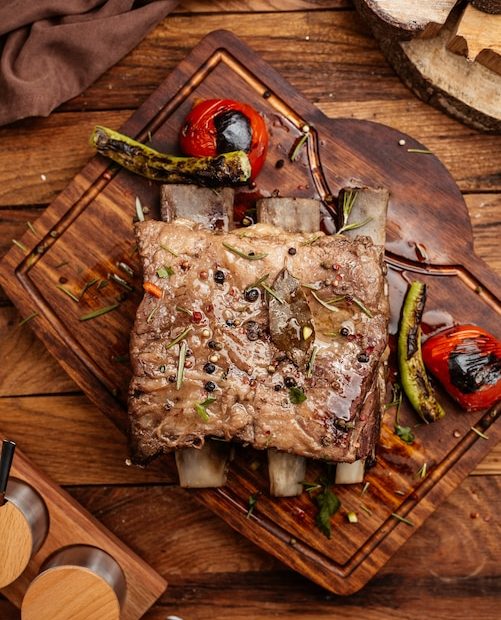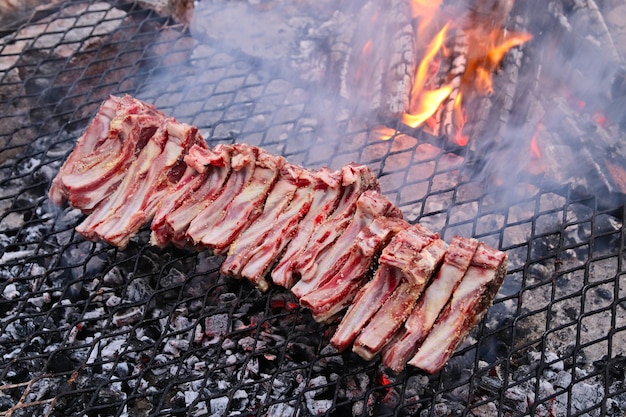How should I prep my ribs?
Preparing ribs for cooking involves several steps to ensure they turn out tender, flavorful, and delicious. Whether you are grilling, smoking, or baking your ribs, proper preparation is key to achieving the best results. In this article, we will guide you through the process of prepping your ribs, from selecting the right cut to applying marinades and rubs.
Selecting the Right Ribs
There are various types of ribs available, but the most popular choices in the UK are baby back ribs and spare ribs. Baby back ribs are smaller and more tender, while spare ribs are larger with more meat and fat. Both cuts can be delicious when prepared correctly, so it ultimately comes down to personal preference.
Removing the Membrane
Before seasoning your ribs, it’s important to remove the tough membrane on the bone side. This membrane can prevent flavors from penetrating the meat and make the ribs chewy. To remove it, use a small knife to lift one corner of the membrane, then grip it with a paper towel and peel it off in one piece. This step may require some patience, but it’s well worth the effort.
Making Marinades and Rubs
Marinades and rubs add flavor and help tenderize the meat. For marinating, you can use a mixture of ingredients such as soy sauce, Worcestershire sauce, garlic, honey, and spices. Allow the ribs to marinate for at least a few hours or overnight in the refrigerator for maximum flavor.
If you prefer to use a dry rub, mix together herbs, spices, sugar, salt, and pepper to create a flavorful blend. Pat the rub onto the ribs, ensuring they are evenly coated. Let the ribs sit for a while to allow the flavors to penetrate the meat before cooking.
Cooking Methods
There are several cooking methods you can choose from when preparing ribs. Grilling and smoking are popular options that infuse smoky flavors into the meat. Alternatively, you can bake your ribs in the oven for a more convenient and controlled cooking process.
When grilling, preheat the grill to medium heat and place the ribs bone-side down. Cook them for about 1-2 hours, turning occasionally and basting with sauce if desired. For smoking, use wood chips to create smoke and cook the ribs at a lower temperature for a longer period to achieve that tender, fall-off-the-bone texture.
If you prefer baking, preheat the oven to a low temperature (around 275°F/135°C) and cook the ribs wrapped in foil for approximately 3-4 hours. This slow and low method ensures tender and juicy ribs.
Remember:
- Always ensure your ribs reach a safe internal temperature of 145°F/63°C for pork.
- Basting with barbecue sauce during the last 30 minutes of cooking can add extra flavor.
- Rest the cooked ribs for a few minutes before cutting into them to allow the juices to redistribute.
“The key to delicious ribs lies in the preparation. Take your time to remove the membrane, marinate or rub your ribs well, and choose the right cooking method. The result will be finger-licking, succulent ribs that will impress your family and friends.” – GrillMasterUK
In conclusion, prepping your ribs involves selecting the right cut, removing the membrane, applying marinades or rubs, and choosing a suitable cooking method. Whether you opt for grilling, smoking, or baking, following these steps will help you achieve mouthwatering ribs that will leave everyone asking for seconds. So, fire up your grill or preheat your oven and get ready to enjoy some deliciously tender ribs!
Do you put butter on ribs?
When it comes to barbecuing ribs, there are many different techniques and recipes to choose from. Some people prefer a dry rub, while others like to marinate their ribs in a sauce. But one question that often comes up is whether or not to put butter on ribs. Let’s take a closer look at this debated topic.
The Butter Debate
Putting butter on ribs is a controversial topic among barbecue enthusiasts. Some argue that adding butter can enhance the flavor and tenderness of the meat, while others believe it is unnecessary. The decision ultimately comes down to personal preference and the desired outcome.
If you’re looking to add richness and a buttery flavor to your ribs, brushing them with melted butter during the cooking process may be worth a try. This can help create a flavorful crust on the outside of the ribs and provide added moisture to the meat.
Alternatives to Butter
If you’re not a fan of using butter on your ribs, there are other options to consider. One popular alternative is using a combination of olive oil and spices to marinate the ribs before grilling. This can help tenderize the meat and add flavor without the use of butter.
Another option is to baste the ribs with a sauce that contains butter or buttery flavors. This can be a good compromise for those who want to incorporate a buttery taste without directly applying butter to the ribs.
Tips for Perfectly Cooked Ribs
No matter which approach you decide to take, here are some tips to ensure your ribs turn out perfectly:
- Choose high-quality ribs from a reputable butcher.
- Remove the membrane from the back of the ribs for better tenderness.
- Apply your chosen seasoning or marinade generously to the ribs.
- Cook the ribs low and slow over indirect heat for tender meat.
- Baste or brush the ribs with your preferred sauce or butter mixture during the cooking process.
- Let the ribs rest for a few minutes after cooking to allow the juices to redistribute.
“Experimenting with different techniques and flavors is part of the fun of barbecuing. Don’t be afraid to try putting butter on your ribs and see if it enhances the taste to your liking.”
Ultimately, whether or not to put butter on your ribs is a matter of personal preference. Some people swear by it, while others prefer alternative methods. The important thing is to experiment and find what works best for you and your taste buds. Happy grilling!
Do you put BBQ sauce on ribs before or after cooking?
Barbecue ribs are a popular dish enjoyed by grilled meat enthusiasts all over the UK. One common debate among barbecue aficionados is whether to apply BBQ sauce on the ribs before or after cooking. There are different schools of thought on this matter, each with its own advantages and flavor profiles.
1. Applying BBQ sauce before cooking:
Some pitmasters prefer to apply BBQ sauce on the ribs before cooking. This method allows the sauce to caramelize and create a flavorful crust on the meat during the grilling process. By brushing the sauce onto the ribs before cooking, it infuses the meat with the sauce’s taste while also adding moisture to prevent drying out.
2. Applying BBQ sauce after cooking:
On the other hand, applying BBQ sauce after cooking is another popular approach. This method prevents the sauce from burning during the high heat of the grill, ensuring a smoother and more consistent texture. It also allows you to layer multiple coats of sauce, resulting in a richer flavor profile.
3. The best of both worlds:
If you can’t decide which method to follow, you can always adopt a combination of both approaches. Start by seasoning the ribs with your desired rub or marinade and then cook them low and slow. During the last 15-30 minutes of cooking, brush the ribs with BBQ sauce to allow it to glaze and set.
Remember: Whichever method you choose, be sure to monitor your cooking closely to prevent the sauce from burning or becoming too sticky. Experimenting with different sauces and techniques will help you find your perfect rib recipe.
“Applying BBQ sauce before cooking gives the ribs a caramelized flavor, while applying it after cooking allows for layering and a richer taste.” – BBQ enthusiast
To summarize, the decision of when to apply BBQ sauce on ribs before or after cooking ultimately comes down to personal preference. Both methods have their own merits, so feel free to try out different approaches and find the one that suits your taste buds best.


